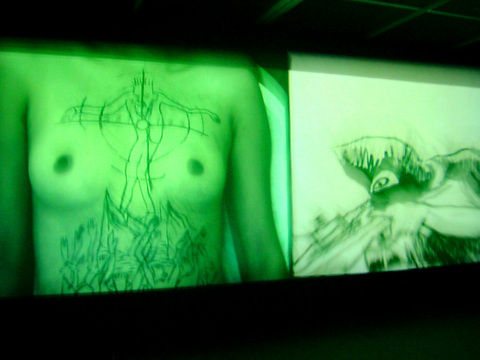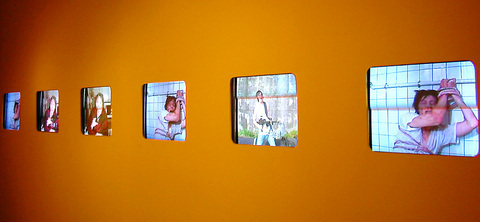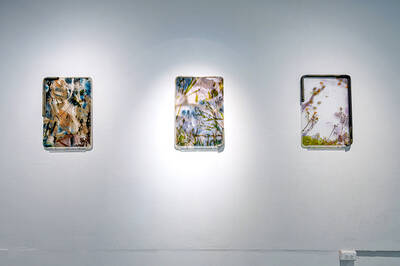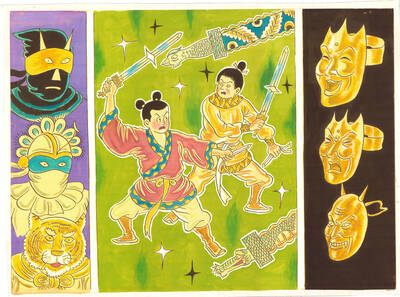Contemporary art institutions in Taiwan are trying to improve the situation for local curators, because it's not only artists who play an integral part in an exhibition, but it is also the curator who, like the orchestra conductor, unites all the creative talents into one powerful dynamic.
The current series Curators in MOCA, 2005 at the Museum of Contemporary Art is showcasing separate exhibitions by four Taiwanese curators.

PHOTO: SUSAN KENDZULAK
The first of the series, on view to March 20, is by JJ Shih (

Despite the title and vague curatorial statement, the exhibition is a good opportunity to see artists living in Taiwan who incorporate the local environment while also keeping a pulse on global contemporary culture. In art circles this is referred as the "glocal," meaning global plus local.
A strong tactile sense prevails along with strong artistic individuality. The exhibition includes some knockouts, though there are some misses. Yet it is that unevenness, that anti-slickness, that sets up a lively debate in one's mind. Energetic, fresh ideas emerge from the exhibition as it allows for a mental sparring in which the viewer can take great pleasure in discerning which art installations work and which ones don't -- the process that makes looking at art such great fun.

Some of the works use kitsch and consumerism as part of the vocabulary. Hong Yi's (
Onion Hsu's (
Su Hui-yu's (
The work parodies conventional media imagery and angst-ridden messages in art. It's a great example of work that embraces the local cultural context but can be read in the global context too, while also being simultaneously deep and light-hearted.
An artist from China, Zhou Xiaohu (
Some works seemed to be indirectly influenced by the popular bestseller The Da Vinci Code, as several of the installations incorporated spiritual symbols begging to be decoded. Maybe it is unintentional, but it is difficult to look at such mysterious symbols without thinking of the influential book.
Chen Hui-chiao's (
Sakuliu's (
Some of the interactive works fall flat rather than engage. Liang Jen-hong's (梁任宏) projection of dripping water on an actual rock seems like a technical exercise rather than a metaphorical one. The same with Chen Chu-ying's (陳珠櫻) digitally activated floor mat. Lin Huang-ti's (林煌迪) installation of paintings and photos doesn't make clear what he is trying to convey.
And the inclusion and large amount of exhibition space devoted to the Taishan Doll Museum (
With these exceptions however, the exhibition successfully shows the vitality of Taiwan's young art scene.
Event Information:
What: Pseudo Hackers Art in Parallel Zones, the first exhibition in the series Curators in MOCA, 2005
Where: Museum of Contemporary Art (
When: Tuesday to Sunday, 10am to 6pm, until March 20.
Telephone: (02) 2552 3721
Details: Admission NT$50, www.mocataipei.org.tw
Pseudo Hackers

In late October of 1873 the government of Japan decided against sending a military expedition to Korea to force that nation to open trade relations. Across the government supporters of the expedition resigned immediately. The spectacle of revolt by disaffected samurai began to loom over Japanese politics. In January of 1874 disaffected samurai attacked a senior minister in Tokyo. A month later, a group of pro-Korea expedition and anti-foreign elements from Saga prefecture in Kyushu revolted, driven in part by high food prices stemming from poor harvests. Their leader, according to Edward Drea’s classic Japan’s Imperial Army, was a samurai

Located down a sideroad in old Wanhua District (萬華區), Waley Art (水谷藝術) has an established reputation for curating some of the more provocative indie art exhibitions in Taipei. And this month is no exception. Beyond the innocuous facade of a shophouse, the full three stories of the gallery space (including the basement) have been taken over by photographs, installation videos and abstract images courtesy of two creatives who hail from the opposite ends of the earth, Taiwan’s Hsu Yi-ting (許懿婷) and Germany’s Benjamin Janzen. “In 2019, I had an art residency in Europe,” Hsu says. “I met Benjamin in the lobby

April 22 to April 28 The true identity of the mastermind behind the Demon Gang (魔鬼黨) was undoubtedly on the minds of countless schoolchildren in late 1958. In the days leading up to the big reveal, more than 10,000 guesses were sent to Ta Hwa Publishing Co (大華文化社) for a chance to win prizes. The smash success of the comic series Great Battle Against the Demon Gang (大戰魔鬼黨) came as a surprise to author Yeh Hung-chia (葉宏甲), who had long given up on his dream after being jailed for 10 months in 1947 over political cartoons. Protagonist

Peter Brighton was amazed when he found the giant jackfruit. He had been watching it grow on his farm in far north Queensland, and when it came time to pick it from the tree, it was so heavy it needed two people to do the job. “I was surprised when we cut it off and felt how heavy it was,” he says. “I grabbed it and my wife cut it — couldn’t do it by myself, it took two of us.” Weighing in at 45 kilograms, it is the heaviest jackfruit that Brighton has ever grown on his tropical fruit farm, located